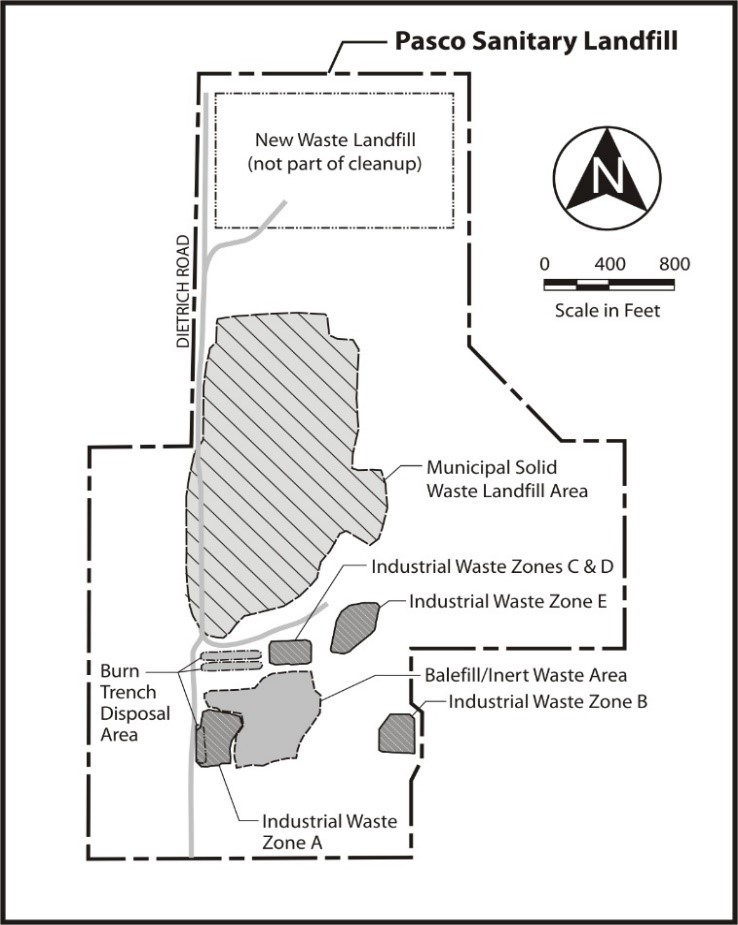
The thermal treatment system for soil contamination in Zone A of the Pasco Landfill.
People north of the intersection of Highway 12 and E. Lewis St.-Kahlotus Rd. in Pasco may see crews in their neighborhood completing field work to monitor and clean up a recent increase in groundwater contamination from the Pasco Landfill Superfund site.
In 2022, we oversaw the removal of more than 35,000 drums of industrial waste from Zone A of the landfill. The recent increase in groundwater contamination happened when chemicals being removed from soil around where drums were buried were not fully captured by the thermal treatment system.
Groundwater is not a source of drinking water for local residents and businesses, and people are not currently at risk. We are working closely with the parties responsible for cleanup to increase chemical recovery from soil and groundwater and ensure public safety.
Your input needed
Through January 20, 2025, we invite your input on the amended enforcement order to address the recent groundwater contamination. The amended order requires the parties responsible for cleanup to:
- Increase groundwater monitoring and treat the recent groundwater contamination to contain it
- Protect air quality in nearby buildings by assessing whether contaminant levels in groundwater could cause unsafe levels of contaminants to build up indoors, called vapor intrusion
The amended order includes a cleanup plan, scope of work, and schedule for completing the new activities.
How to comment
- Online comment form
- Email Jeremy.Schmidt@ecy.wa.gov
- Mail: 4601 N. Monroe St., Spokane, WA 99205
The order went into effect November 20, the day we issued it. The parties responsible for cleanup have already begun the required work to address the situation as quickly as possible.
“While we are disappointed about the recent release of groundwater contamination off the Pasco Landfill property, we are encouraged by the quick action, collaboration, and technical expertise between Ecology and the responsible parties,” said Nick Acklam, Eastern Region manager of the Toxics Cleanup Program. “This work will lead to containing and treating the contamination, which will prevent further movement and limit potential impacts to air quality.”
In April 2024, contractors started up the thermal treatment system in the first of two areas where contaminated soil remained in Zone A where drums used to be buried. Since that time, the system has removed and destroyed about 9,100 pounds of chemicals from contaminated soil.
The last round of groundwater data we received in early November showed increasing contamination in on-property monitoring wells. We immediately began working with the cleanup contractors to restart groundwater treatment and assess contaminant levels in soil vapor to determine if vapor intrusion is a concern.
Cleanup history
Following the completion of thermal treatment in the second area, a final cover system will be placed on Zone A, and the site will continue to be restricted with fences, signs, and limitations on how the property is used.
Groundwater monitoring and the maintenance of landfill covers will continue beyond the completion of active cleanup. The groundwater protection area around part of east Pasco will stay in place until Ecology determines it is no longer necessary.
About the Pasco Landfill
The Pasco Landfill is approximately 1.5 miles northeast of the City of Pasco and covers nearly 200 acres. The landfill opened in 1958. Waste was burned in trenches until 1971, when the site became a sanitary landfill. From 1972 to 1975, the landfill accepted industrial waste.
The Environmental Protection Agency added the site to the National Priorities List in 1990. Ecology took oversight responsibility in 1991, and the landfill closed in 2001. Ongoing cleanup over the past two decades has reduced groundwater contamination at the landfill property and in off-property areas. Removing the buried drums and thermally treating remaining contaminated soil will continue to ensure people and the environment are protected.


